SRR782 - Construction Waste Reduction in Developing Nations
VerifiedAdded on 2023/06/13
|12
|2812
|101
Annotated Bibliography
AI Summary
This assignment presents an annotated bibliography focusing on the reduction of construction waste in large-scale projects within developing countries. It includes an analysis of seminal journals and articles, highlighting the importance of waste management practices, critical factors in waste minimization at the design stage, and key indicators for assessing the effectiveness of waste management. The scope of the research is diagrammed to illustrate the research's importance, topics addressed, and its grounding in sustainable building practices. A literature review underscores the significant environmental impact of construction activities and the necessity for improved waste reduction strategies, particularly in developing nations like India, where construction contributes substantially to the GDP but faces challenges related to waste management, knowledge gaps among stakeholders, and adherence to standards.
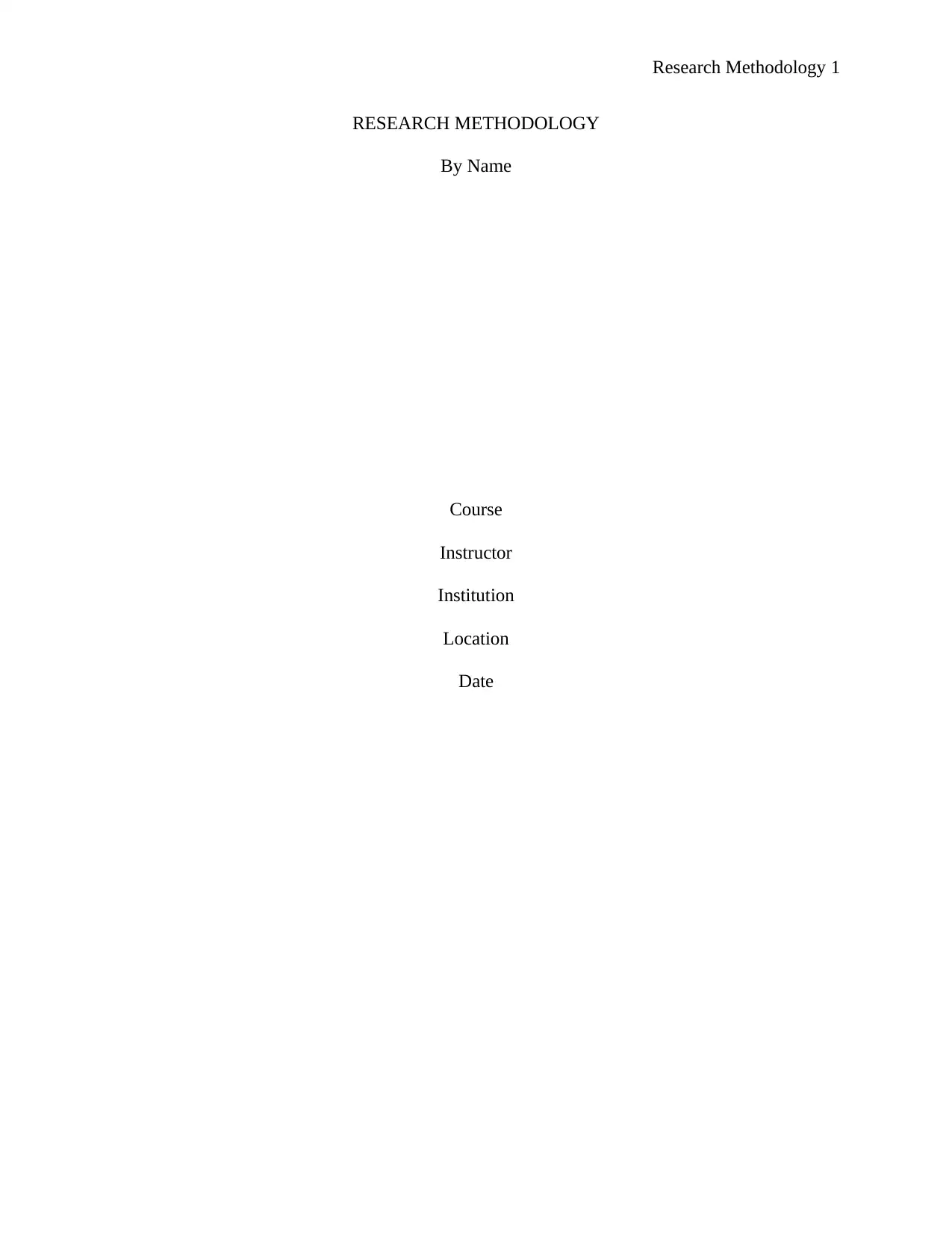
Research Methodology 1
RESEARCH METHODOLOGY
By Name
Course
Instructor
Institution
Location
Date
RESEARCH METHODOLOGY
By Name
Course
Instructor
Institution
Location
Date
Paraphrase This Document
Need a fresh take? Get an instant paraphrase of this document with our AI Paraphraser
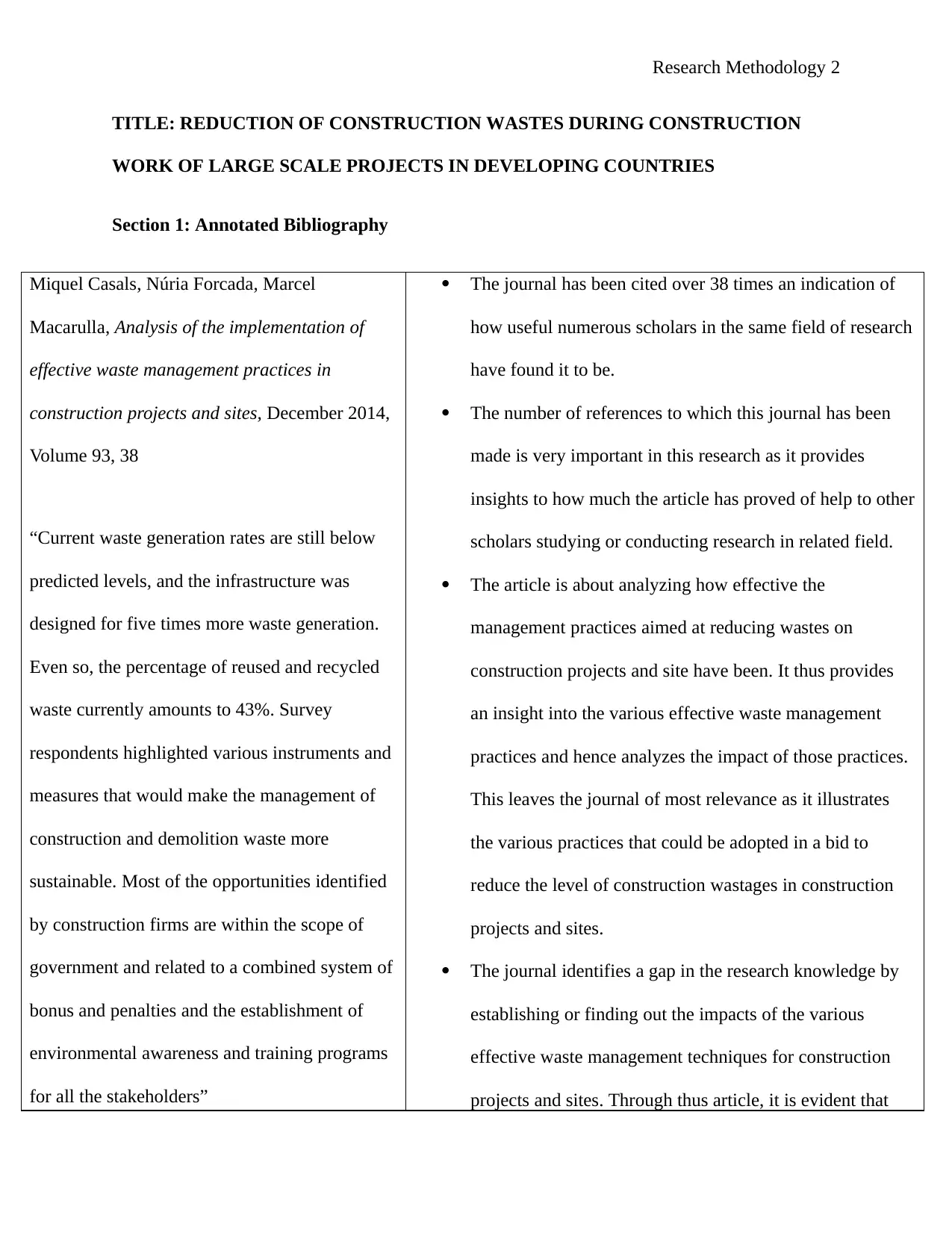
Research Methodology 2
TITLE: REDUCTION OF CONSTRUCTION WASTES DURING CONSTRUCTION
WORK OF LARGE SCALE PROJECTS IN DEVELOPING COUNTRIES
Section 1: Annotated Bibliography
Miquel Casals, Núria Forcada, Marcel
Macarulla, Analysis of the implementation of
effective waste management practices in
construction projects and sites, December 2014,
Volume 93, 38
“Current waste generation rates are still below
predicted levels, and the infrastructure was
designed for five times more waste generation.
Even so, the percentage of reused and recycled
waste currently amounts to 43%. Survey
respondents highlighted various instruments and
measures that would make the management of
construction and demolition waste more
sustainable. Most of the opportunities identified
by construction firms are within the scope of
government and related to a combined system of
bonus and penalties and the establishment of
environmental awareness and training programs
for all the stakeholders”
The journal has been cited over 38 times an indication of
how useful numerous scholars in the same field of research
have found it to be.
The number of references to which this journal has been
made is very important in this research as it provides
insights to how much the article has proved of help to other
scholars studying or conducting research in related field.
The article is about analyzing how effective the
management practices aimed at reducing wastes on
construction projects and site have been. It thus provides
an insight into the various effective waste management
practices and hence analyzes the impact of those practices.
This leaves the journal of most relevance as it illustrates
the various practices that could be adopted in a bid to
reduce the level of construction wastages in construction
projects and sites.
The journal identifies a gap in the research knowledge by
establishing or finding out the impacts of the various
effective waste management techniques for construction
projects and sites. Through thus article, it is evident that
TITLE: REDUCTION OF CONSTRUCTION WASTES DURING CONSTRUCTION
WORK OF LARGE SCALE PROJECTS IN DEVELOPING COUNTRIES
Section 1: Annotated Bibliography
Miquel Casals, Núria Forcada, Marcel
Macarulla, Analysis of the implementation of
effective waste management practices in
construction projects and sites, December 2014,
Volume 93, 38
“Current waste generation rates are still below
predicted levels, and the infrastructure was
designed for five times more waste generation.
Even so, the percentage of reused and recycled
waste currently amounts to 43%. Survey
respondents highlighted various instruments and
measures that would make the management of
construction and demolition waste more
sustainable. Most of the opportunities identified
by construction firms are within the scope of
government and related to a combined system of
bonus and penalties and the establishment of
environmental awareness and training programs
for all the stakeholders”
The journal has been cited over 38 times an indication of
how useful numerous scholars in the same field of research
have found it to be.
The number of references to which this journal has been
made is very important in this research as it provides
insights to how much the article has proved of help to other
scholars studying or conducting research in related field.
The article is about analyzing how effective the
management practices aimed at reducing wastes on
construction projects and site have been. It thus provides
an insight into the various effective waste management
practices and hence analyzes the impact of those practices.
This leaves the journal of most relevance as it illustrates
the various practices that could be adopted in a bid to
reduce the level of construction wastages in construction
projects and sites.
The journal identifies a gap in the research knowledge by
establishing or finding out the impacts of the various
effective waste management techniques for construction
projects and sites. Through thus article, it is evident that
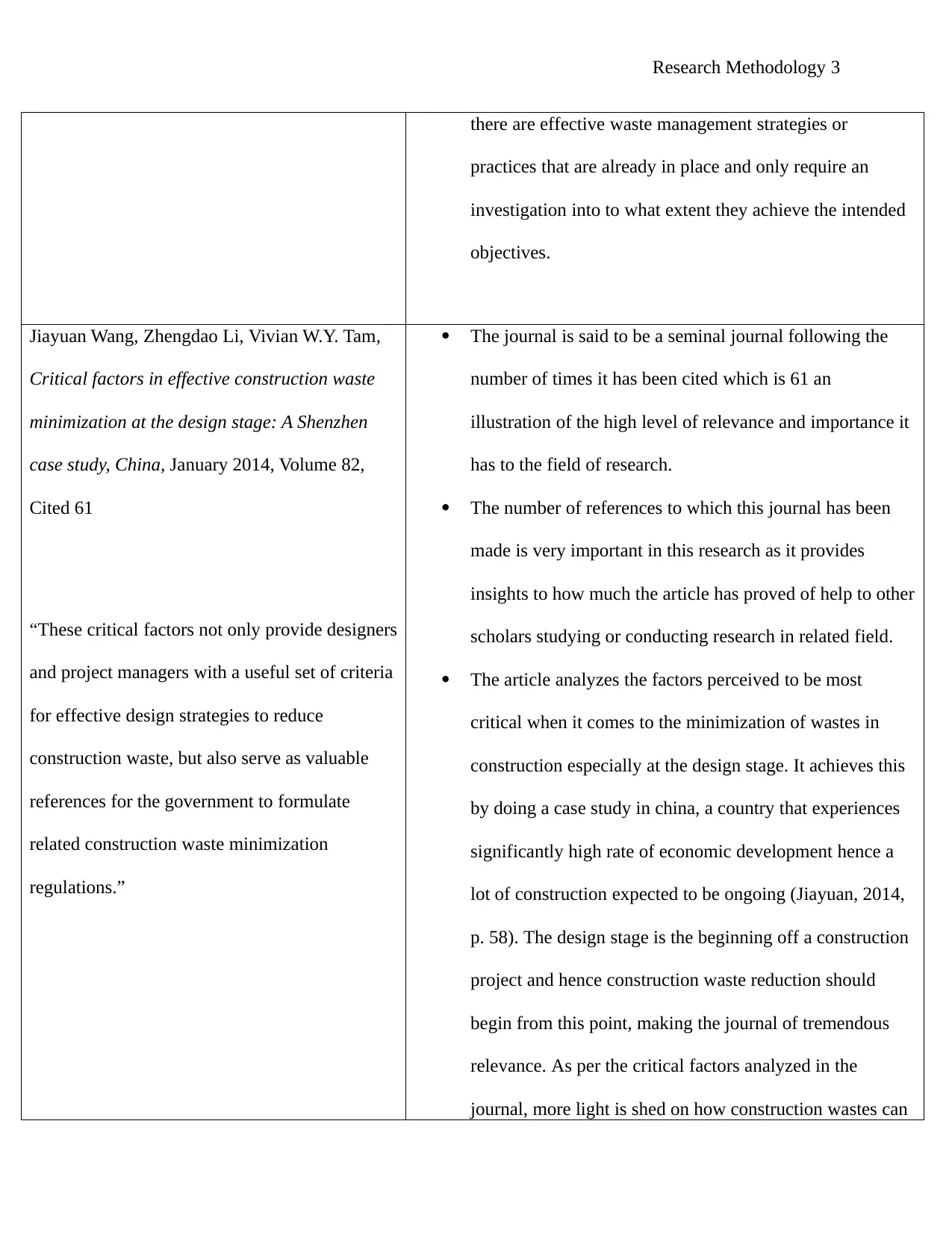
Research Methodology 3
there are effective waste management strategies or
practices that are already in place and only require an
investigation into to what extent they achieve the intended
objectives.
Jiayuan Wang, Zhengdao Li, Vivian W.Y. Tam,
Critical factors in effective construction waste
minimization at the design stage: A Shenzhen
case study, China, January 2014, Volume 82,
Cited 61
“These critical factors not only provide designers
and project managers with a useful set of criteria
for effective design strategies to reduce
construction waste, but also serve as valuable
references for the government to formulate
related construction waste minimization
regulations.”
The journal is said to be a seminal journal following the
number of times it has been cited which is 61 an
illustration of the high level of relevance and importance it
has to the field of research.
The number of references to which this journal has been
made is very important in this research as it provides
insights to how much the article has proved of help to other
scholars studying or conducting research in related field.
The article analyzes the factors perceived to be most
critical when it comes to the minimization of wastes in
construction especially at the design stage. It achieves this
by doing a case study in china, a country that experiences
significantly high rate of economic development hence a
lot of construction expected to be ongoing (Jiayuan, 2014,
p. 58). The design stage is the beginning off a construction
project and hence construction waste reduction should
begin from this point, making the journal of tremendous
relevance. As per the critical factors analyzed in the
journal, more light is shed on how construction wastes can
there are effective waste management strategies or
practices that are already in place and only require an
investigation into to what extent they achieve the intended
objectives.
Jiayuan Wang, Zhengdao Li, Vivian W.Y. Tam,
Critical factors in effective construction waste
minimization at the design stage: A Shenzhen
case study, China, January 2014, Volume 82,
Cited 61
“These critical factors not only provide designers
and project managers with a useful set of criteria
for effective design strategies to reduce
construction waste, but also serve as valuable
references for the government to formulate
related construction waste minimization
regulations.”
The journal is said to be a seminal journal following the
number of times it has been cited which is 61 an
illustration of the high level of relevance and importance it
has to the field of research.
The number of references to which this journal has been
made is very important in this research as it provides
insights to how much the article has proved of help to other
scholars studying or conducting research in related field.
The article analyzes the factors perceived to be most
critical when it comes to the minimization of wastes in
construction especially at the design stage. It achieves this
by doing a case study in china, a country that experiences
significantly high rate of economic development hence a
lot of construction expected to be ongoing (Jiayuan, 2014,
p. 58). The design stage is the beginning off a construction
project and hence construction waste reduction should
begin from this point, making the journal of tremendous
relevance. As per the critical factors analyzed in the
journal, more light is shed on how construction wastes can
⊘ This is a preview!⊘
Do you want full access?
Subscribe today to unlock all pages.

Trusted by 1+ million students worldwide
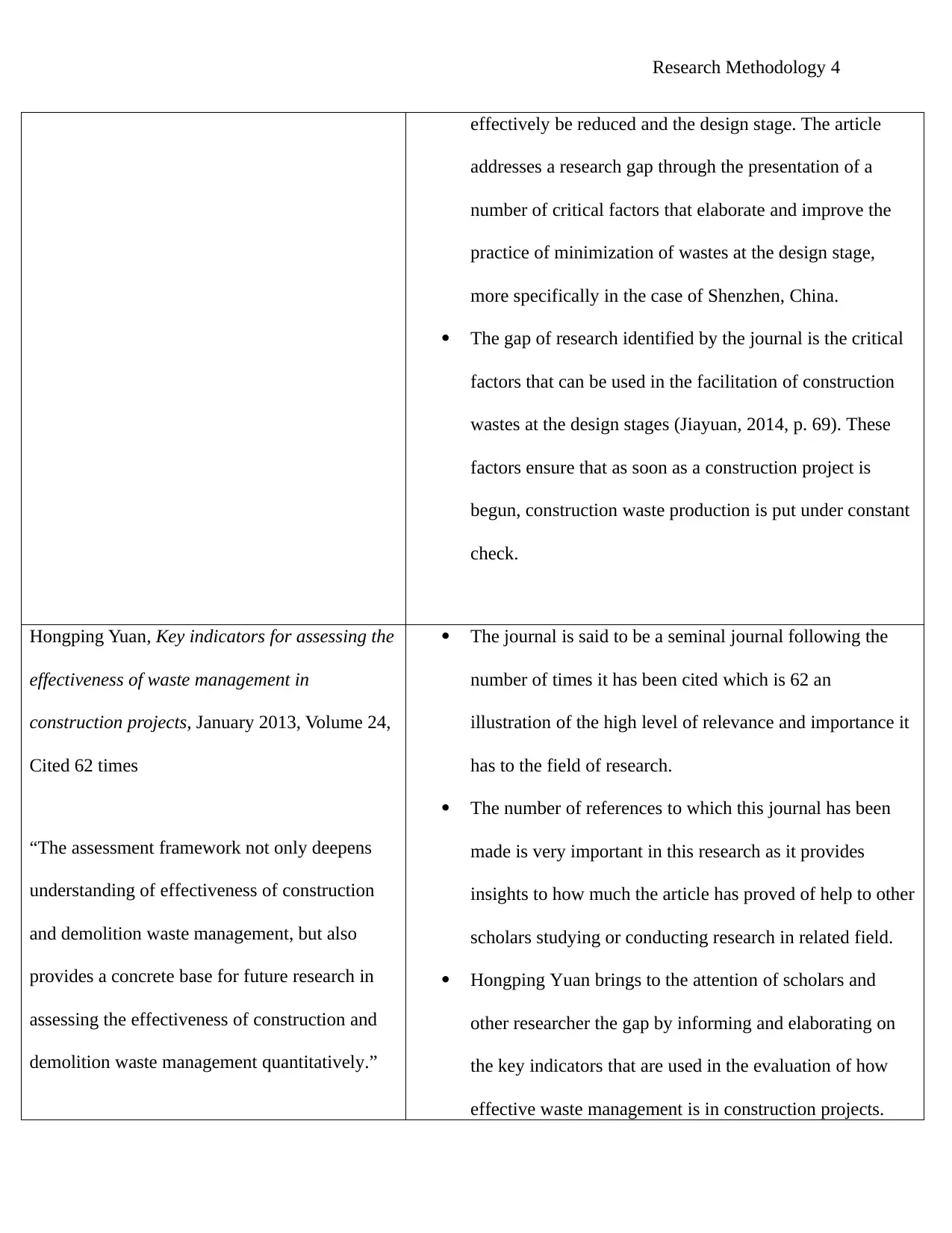
Research Methodology 4
effectively be reduced and the design stage. The article
addresses a research gap through the presentation of a
number of critical factors that elaborate and improve the
practice of minimization of wastes at the design stage,
more specifically in the case of Shenzhen, China.
The gap of research identified by the journal is the critical
factors that can be used in the facilitation of construction
wastes at the design stages (Jiayuan, 2014, p. 69). These
factors ensure that as soon as a construction project is
begun, construction waste production is put under constant
check.
Hongping Yuan, Key indicators for assessing the
effectiveness of waste management in
construction projects, January 2013, Volume 24,
Cited 62 times
“The assessment framework not only deepens
understanding of effectiveness of construction
and demolition waste management, but also
provides a concrete base for future research in
assessing the effectiveness of construction and
demolition waste management quantitatively.”
The journal is said to be a seminal journal following the
number of times it has been cited which is 62 an
illustration of the high level of relevance and importance it
has to the field of research.
The number of references to which this journal has been
made is very important in this research as it provides
insights to how much the article has proved of help to other
scholars studying or conducting research in related field.
Hongping Yuan brings to the attention of scholars and
other researcher the gap by informing and elaborating on
the key indicators that are used in the evaluation of how
effective waste management is in construction projects.
effectively be reduced and the design stage. The article
addresses a research gap through the presentation of a
number of critical factors that elaborate and improve the
practice of minimization of wastes at the design stage,
more specifically in the case of Shenzhen, China.
The gap of research identified by the journal is the critical
factors that can be used in the facilitation of construction
wastes at the design stages (Jiayuan, 2014, p. 69). These
factors ensure that as soon as a construction project is
begun, construction waste production is put under constant
check.
Hongping Yuan, Key indicators for assessing the
effectiveness of waste management in
construction projects, January 2013, Volume 24,
Cited 62 times
“The assessment framework not only deepens
understanding of effectiveness of construction
and demolition waste management, but also
provides a concrete base for future research in
assessing the effectiveness of construction and
demolition waste management quantitatively.”
The journal is said to be a seminal journal following the
number of times it has been cited which is 62 an
illustration of the high level of relevance and importance it
has to the field of research.
The number of references to which this journal has been
made is very important in this research as it provides
insights to how much the article has proved of help to other
scholars studying or conducting research in related field.
Hongping Yuan brings to the attention of scholars and
other researcher the gap by informing and elaborating on
the key indicators that are used in the evaluation of how
effective waste management is in construction projects.
Paraphrase This Document
Need a fresh take? Get an instant paraphrase of this document with our AI Paraphraser
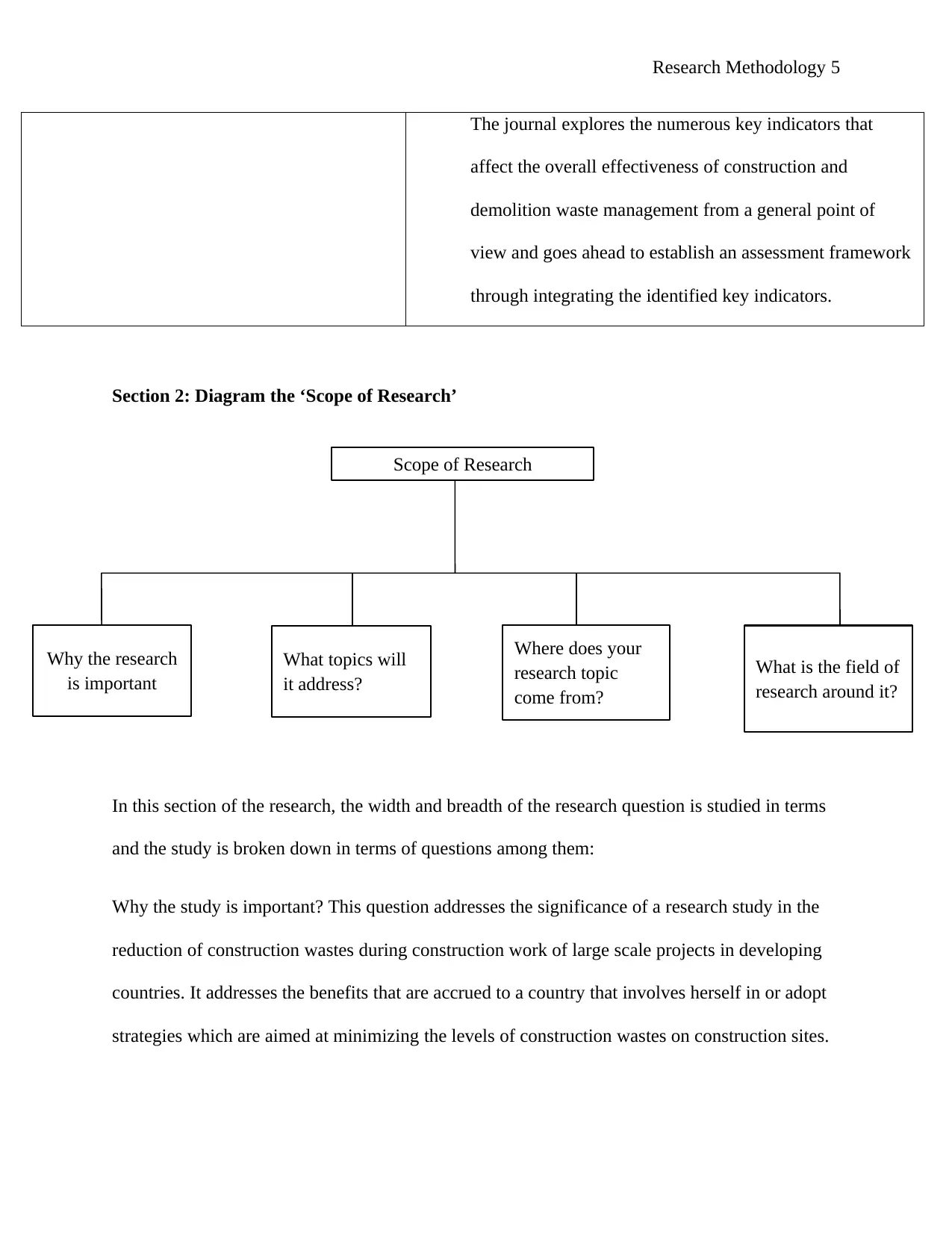
Research Methodology 5
The journal explores the numerous key indicators that
affect the overall effectiveness of construction and
demolition waste management from a general point of
view and goes ahead to establish an assessment framework
through integrating the identified key indicators.
Section 2: Diagram the ‘Scope of Research’
In this section of the research, the width and breadth of the research question is studied in terms
and the study is broken down in terms of questions among them:
Why the study is important? This question addresses the significance of a research study in the
reduction of construction wastes during construction work of large scale projects in developing
countries. It addresses the benefits that are accrued to a country that involves herself in or adopt
strategies which are aimed at minimizing the levels of construction wastes on construction sites.
Scope of Research
Why the research
is important
Where does your
research topic
come from?
What is the field of
research around it?
What topics will
it address?
The journal explores the numerous key indicators that
affect the overall effectiveness of construction and
demolition waste management from a general point of
view and goes ahead to establish an assessment framework
through integrating the identified key indicators.
Section 2: Diagram the ‘Scope of Research’
In this section of the research, the width and breadth of the research question is studied in terms
and the study is broken down in terms of questions among them:
Why the study is important? This question addresses the significance of a research study in the
reduction of construction wastes during construction work of large scale projects in developing
countries. It addresses the benefits that are accrued to a country that involves herself in or adopt
strategies which are aimed at minimizing the levels of construction wastes on construction sites.
Scope of Research
Why the research
is important
Where does your
research topic
come from?
What is the field of
research around it?
What topics will
it address?
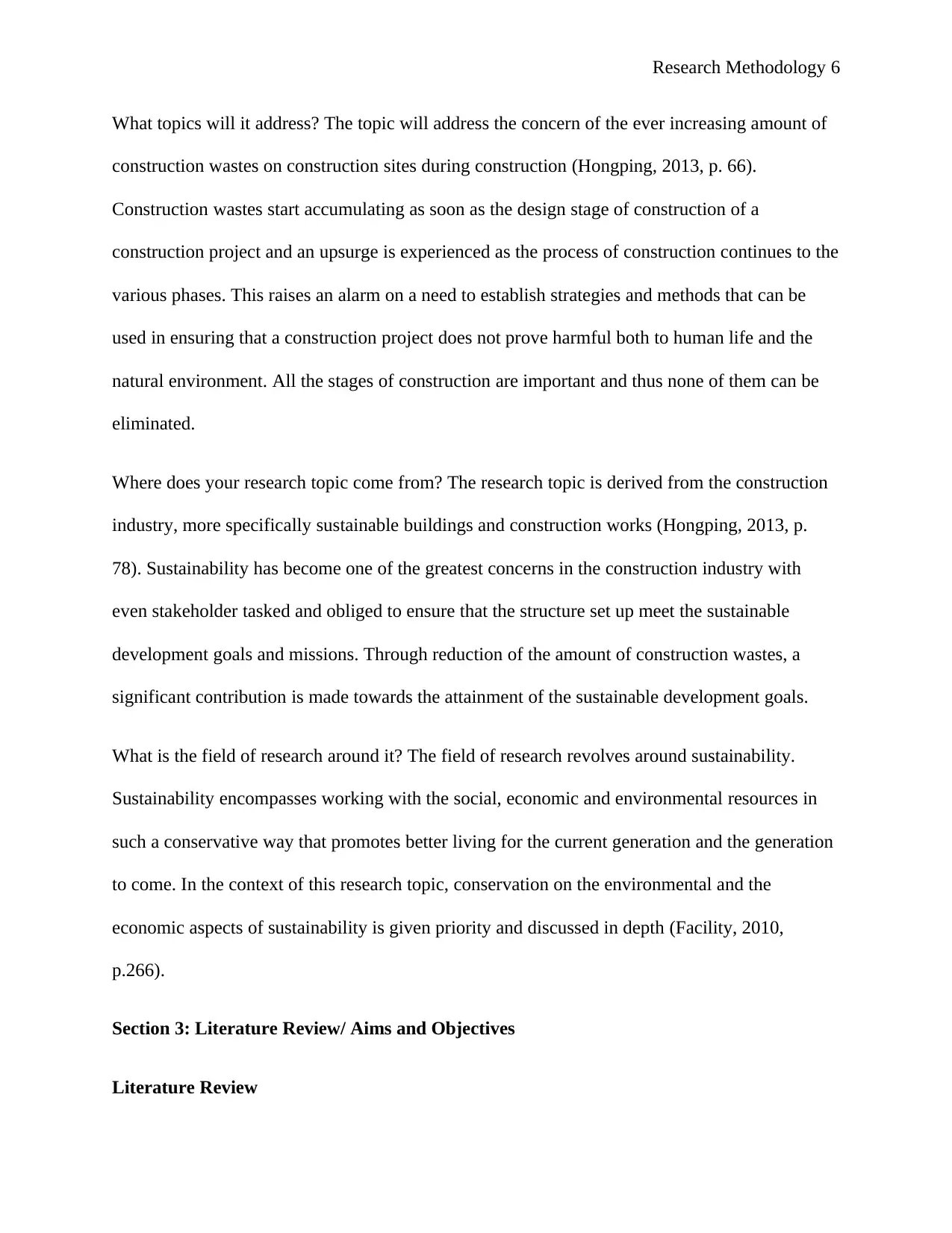
Research Methodology 6
What topics will it address? The topic will address the concern of the ever increasing amount of
construction wastes on construction sites during construction (Hongping, 2013, p. 66).
Construction wastes start accumulating as soon as the design stage of construction of a
construction project and an upsurge is experienced as the process of construction continues to the
various phases. This raises an alarm on a need to establish strategies and methods that can be
used in ensuring that a construction project does not prove harmful both to human life and the
natural environment. All the stages of construction are important and thus none of them can be
eliminated.
Where does your research topic come from? The research topic is derived from the construction
industry, more specifically sustainable buildings and construction works (Hongping, 2013, p.
78). Sustainability has become one of the greatest concerns in the construction industry with
even stakeholder tasked and obliged to ensure that the structure set up meet the sustainable
development goals and missions. Through reduction of the amount of construction wastes, a
significant contribution is made towards the attainment of the sustainable development goals.
What is the field of research around it? The field of research revolves around sustainability.
Sustainability encompasses working with the social, economic and environmental resources in
such a conservative way that promotes better living for the current generation and the generation
to come. In the context of this research topic, conservation on the environmental and the
economic aspects of sustainability is given priority and discussed in depth (Facility, 2010,
p.266).
Section 3: Literature Review/ Aims and Objectives
Literature Review
What topics will it address? The topic will address the concern of the ever increasing amount of
construction wastes on construction sites during construction (Hongping, 2013, p. 66).
Construction wastes start accumulating as soon as the design stage of construction of a
construction project and an upsurge is experienced as the process of construction continues to the
various phases. This raises an alarm on a need to establish strategies and methods that can be
used in ensuring that a construction project does not prove harmful both to human life and the
natural environment. All the stages of construction are important and thus none of them can be
eliminated.
Where does your research topic come from? The research topic is derived from the construction
industry, more specifically sustainable buildings and construction works (Hongping, 2013, p.
78). Sustainability has become one of the greatest concerns in the construction industry with
even stakeholder tasked and obliged to ensure that the structure set up meet the sustainable
development goals and missions. Through reduction of the amount of construction wastes, a
significant contribution is made towards the attainment of the sustainable development goals.
What is the field of research around it? The field of research revolves around sustainability.
Sustainability encompasses working with the social, economic and environmental resources in
such a conservative way that promotes better living for the current generation and the generation
to come. In the context of this research topic, conservation on the environmental and the
economic aspects of sustainability is given priority and discussed in depth (Facility, 2010,
p.266).
Section 3: Literature Review/ Aims and Objectives
Literature Review
⊘ This is a preview!⊘
Do you want full access?
Subscribe today to unlock all pages.

Trusted by 1+ million students worldwide
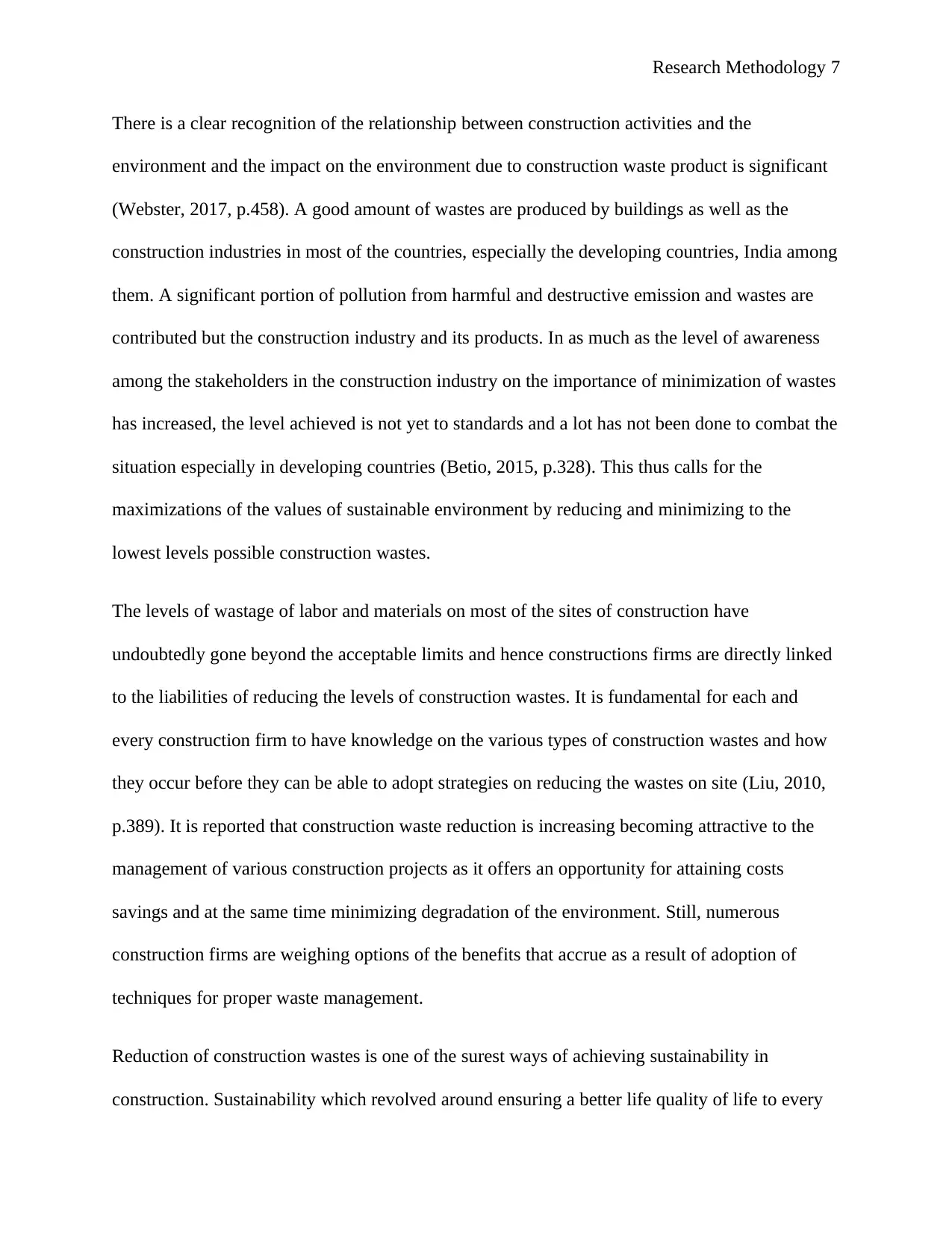
Research Methodology 7
There is a clear recognition of the relationship between construction activities and the
environment and the impact on the environment due to construction waste product is significant
(Webster, 2017, p.458). A good amount of wastes are produced by buildings as well as the
construction industries in most of the countries, especially the developing countries, India among
them. A significant portion of pollution from harmful and destructive emission and wastes are
contributed but the construction industry and its products. In as much as the level of awareness
among the stakeholders in the construction industry on the importance of minimization of wastes
has increased, the level achieved is not yet to standards and a lot has not been done to combat the
situation especially in developing countries (Betio, 2015, p.328). This thus calls for the
maximizations of the values of sustainable environment by reducing and minimizing to the
lowest levels possible construction wastes.
The levels of wastage of labor and materials on most of the sites of construction have
undoubtedly gone beyond the acceptable limits and hence constructions firms are directly linked
to the liabilities of reducing the levels of construction wastes. It is fundamental for each and
every construction firm to have knowledge on the various types of construction wastes and how
they occur before they can be able to adopt strategies on reducing the wastes on site (Liu, 2010,
p.389). It is reported that construction waste reduction is increasing becoming attractive to the
management of various construction projects as it offers an opportunity for attaining costs
savings and at the same time minimizing degradation of the environment. Still, numerous
construction firms are weighing options of the benefits that accrue as a result of adoption of
techniques for proper waste management.
Reduction of construction wastes is one of the surest ways of achieving sustainability in
construction. Sustainability which revolved around ensuring a better life quality of life to every
There is a clear recognition of the relationship between construction activities and the
environment and the impact on the environment due to construction waste product is significant
(Webster, 2017, p.458). A good amount of wastes are produced by buildings as well as the
construction industries in most of the countries, especially the developing countries, India among
them. A significant portion of pollution from harmful and destructive emission and wastes are
contributed but the construction industry and its products. In as much as the level of awareness
among the stakeholders in the construction industry on the importance of minimization of wastes
has increased, the level achieved is not yet to standards and a lot has not been done to combat the
situation especially in developing countries (Betio, 2015, p.328). This thus calls for the
maximizations of the values of sustainable environment by reducing and minimizing to the
lowest levels possible construction wastes.
The levels of wastage of labor and materials on most of the sites of construction have
undoubtedly gone beyond the acceptable limits and hence constructions firms are directly linked
to the liabilities of reducing the levels of construction wastes. It is fundamental for each and
every construction firm to have knowledge on the various types of construction wastes and how
they occur before they can be able to adopt strategies on reducing the wastes on site (Liu, 2010,
p.389). It is reported that construction waste reduction is increasing becoming attractive to the
management of various construction projects as it offers an opportunity for attaining costs
savings and at the same time minimizing degradation of the environment. Still, numerous
construction firms are weighing options of the benefits that accrue as a result of adoption of
techniques for proper waste management.
Reduction of construction wastes is one of the surest ways of achieving sustainability in
construction. Sustainability which revolved around ensuring a better life quality of life to every
Paraphrase This Document
Need a fresh take? Get an instant paraphrase of this document with our AI Paraphraser
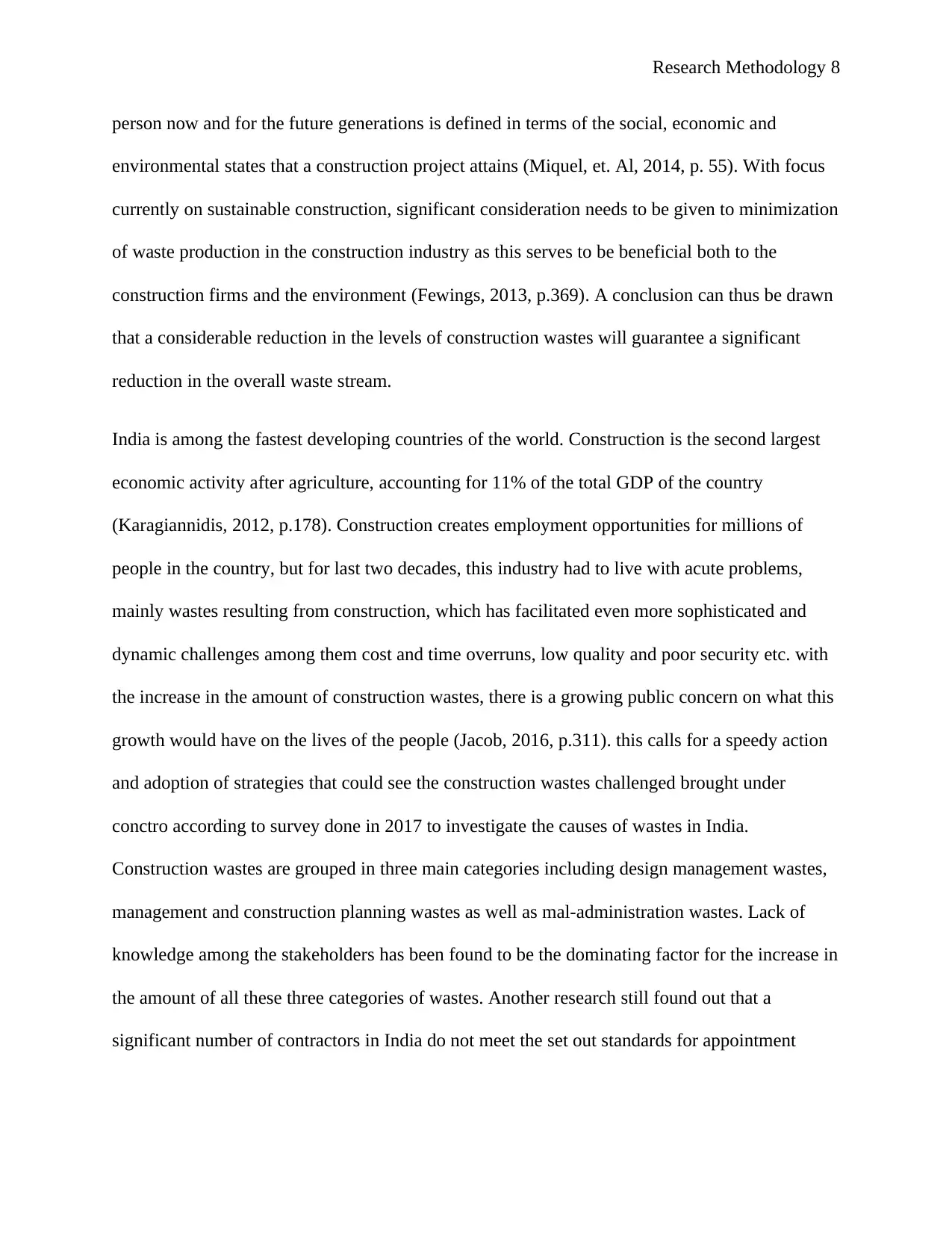
Research Methodology 8
person now and for the future generations is defined in terms of the social, economic and
environmental states that a construction project attains (Miquel, et. Al, 2014, p. 55). With focus
currently on sustainable construction, significant consideration needs to be given to minimization
of waste production in the construction industry as this serves to be beneficial both to the
construction firms and the environment (Fewings, 2013, p.369). A conclusion can thus be drawn
that a considerable reduction in the levels of construction wastes will guarantee a significant
reduction in the overall waste stream.
India is among the fastest developing countries of the world. Construction is the second largest
economic activity after agriculture, accounting for 11% of the total GDP of the country
(Karagiannidis, 2012, p.178). Construction creates employment opportunities for millions of
people in the country, but for last two decades, this industry had to live with acute problems,
mainly wastes resulting from construction, which has facilitated even more sophisticated and
dynamic challenges among them cost and time overruns, low quality and poor security etc. with
the increase in the amount of construction wastes, there is a growing public concern on what this
growth would have on the lives of the people (Jacob, 2016, p.311). this calls for a speedy action
and adoption of strategies that could see the construction wastes challenged brought under
conctro according to survey done in 2017 to investigate the causes of wastes in India.
Construction wastes are grouped in three main categories including design management wastes,
management and construction planning wastes as well as mal-administration wastes. Lack of
knowledge among the stakeholders has been found to be the dominating factor for the increase in
the amount of all these three categories of wastes. Another research still found out that a
significant number of contractors in India do not meet the set out standards for appointment
person now and for the future generations is defined in terms of the social, economic and
environmental states that a construction project attains (Miquel, et. Al, 2014, p. 55). With focus
currently on sustainable construction, significant consideration needs to be given to minimization
of waste production in the construction industry as this serves to be beneficial both to the
construction firms and the environment (Fewings, 2013, p.369). A conclusion can thus be drawn
that a considerable reduction in the levels of construction wastes will guarantee a significant
reduction in the overall waste stream.
India is among the fastest developing countries of the world. Construction is the second largest
economic activity after agriculture, accounting for 11% of the total GDP of the country
(Karagiannidis, 2012, p.178). Construction creates employment opportunities for millions of
people in the country, but for last two decades, this industry had to live with acute problems,
mainly wastes resulting from construction, which has facilitated even more sophisticated and
dynamic challenges among them cost and time overruns, low quality and poor security etc. with
the increase in the amount of construction wastes, there is a growing public concern on what this
growth would have on the lives of the people (Jacob, 2016, p.311). this calls for a speedy action
and adoption of strategies that could see the construction wastes challenged brought under
conctro according to survey done in 2017 to investigate the causes of wastes in India.
Construction wastes are grouped in three main categories including design management wastes,
management and construction planning wastes as well as mal-administration wastes. Lack of
knowledge among the stakeholders has been found to be the dominating factor for the increase in
the amount of all these three categories of wastes. Another research still found out that a
significant number of contractors in India do not meet the set out standards for appointment
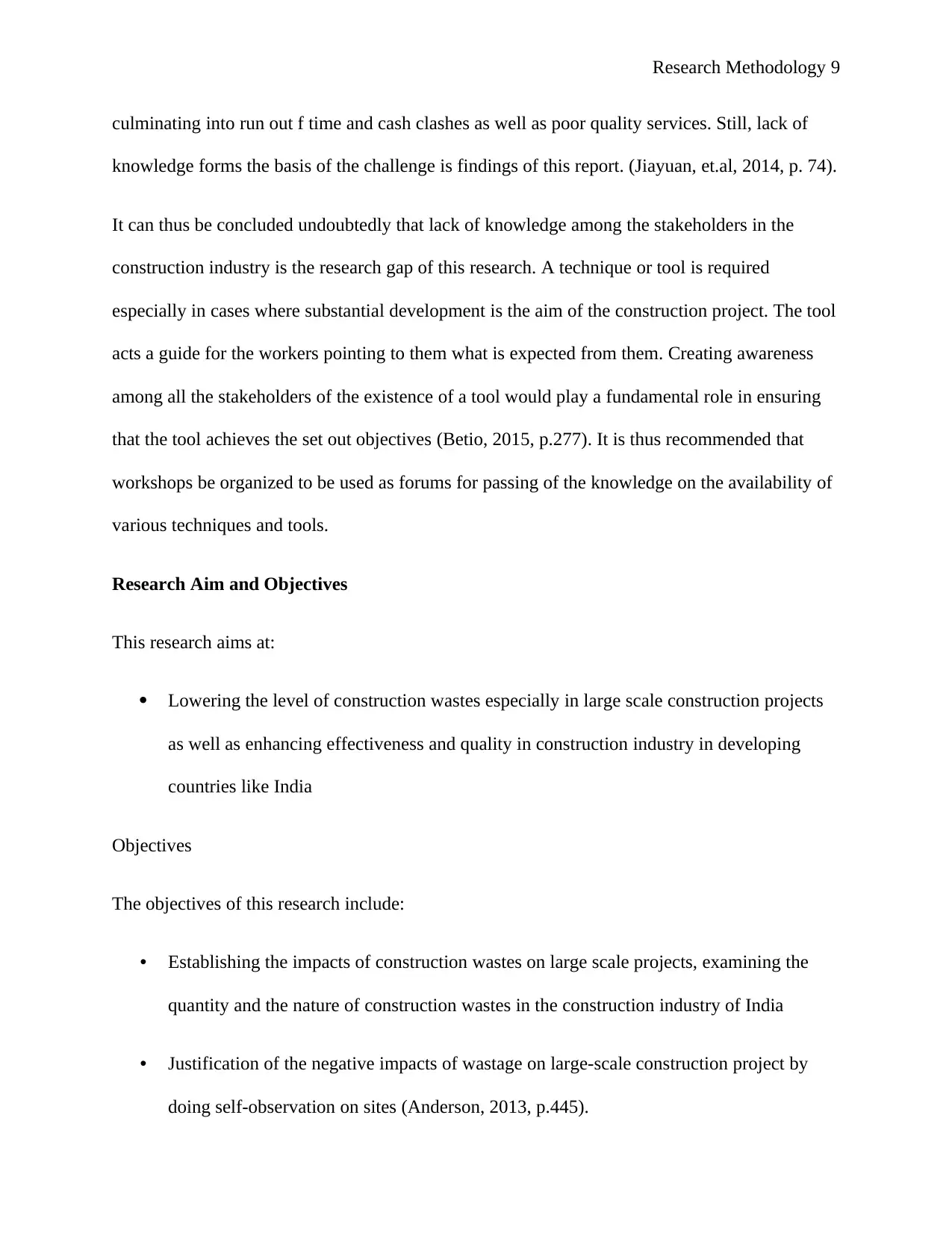
Research Methodology 9
culminating into run out f time and cash clashes as well as poor quality services. Still, lack of
knowledge forms the basis of the challenge is findings of this report. (Jiayuan, et.al, 2014, p. 74).
It can thus be concluded undoubtedly that lack of knowledge among the stakeholders in the
construction industry is the research gap of this research. A technique or tool is required
especially in cases where substantial development is the aim of the construction project. The tool
acts a guide for the workers pointing to them what is expected from them. Creating awareness
among all the stakeholders of the existence of a tool would play a fundamental role in ensuring
that the tool achieves the set out objectives (Betio, 2015, p.277). It is thus recommended that
workshops be organized to be used as forums for passing of the knowledge on the availability of
various techniques and tools.
Research Aim and Objectives
This research aims at:
Lowering the level of construction wastes especially in large scale construction projects
as well as enhancing effectiveness and quality in construction industry in developing
countries like India
Objectives
The objectives of this research include:
• Establishing the impacts of construction wastes on large scale projects, examining the
quantity and the nature of construction wastes in the construction industry of India
• Justification of the negative impacts of wastage on large-scale construction project by
doing self-observation on sites (Anderson, 2013, p.445).
culminating into run out f time and cash clashes as well as poor quality services. Still, lack of
knowledge forms the basis of the challenge is findings of this report. (Jiayuan, et.al, 2014, p. 74).
It can thus be concluded undoubtedly that lack of knowledge among the stakeholders in the
construction industry is the research gap of this research. A technique or tool is required
especially in cases where substantial development is the aim of the construction project. The tool
acts a guide for the workers pointing to them what is expected from them. Creating awareness
among all the stakeholders of the existence of a tool would play a fundamental role in ensuring
that the tool achieves the set out objectives (Betio, 2015, p.277). It is thus recommended that
workshops be organized to be used as forums for passing of the knowledge on the availability of
various techniques and tools.
Research Aim and Objectives
This research aims at:
Lowering the level of construction wastes especially in large scale construction projects
as well as enhancing effectiveness and quality in construction industry in developing
countries like India
Objectives
The objectives of this research include:
• Establishing the impacts of construction wastes on large scale projects, examining the
quantity and the nature of construction wastes in the construction industry of India
• Justification of the negative impacts of wastage on large-scale construction project by
doing self-observation on sites (Anderson, 2013, p.445).
⊘ This is a preview!⊘
Do you want full access?
Subscribe today to unlock all pages.

Trusted by 1+ million students worldwide
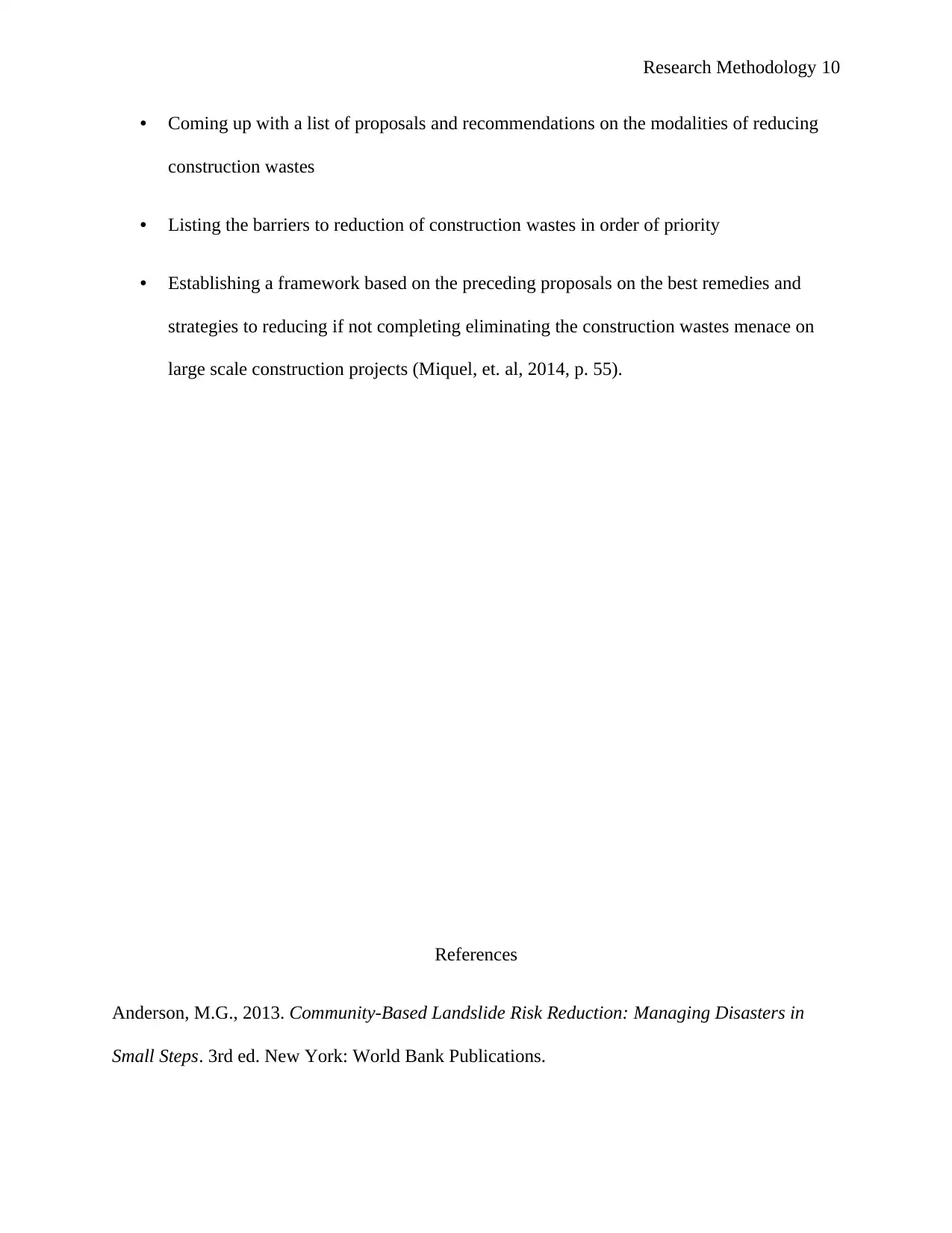
Research Methodology 10
• Coming up with a list of proposals and recommendations on the modalities of reducing
construction wastes
• Listing the barriers to reduction of construction wastes in order of priority
• Establishing a framework based on the preceding proposals on the best remedies and
strategies to reducing if not completing eliminating the construction wastes menace on
large scale construction projects (Miquel, et. al, 2014, p. 55).
References
Anderson, M.G., 2013. Community-Based Landslide Risk Reduction: Managing Disasters in
Small Steps. 3rd ed. New York: World Bank Publications.
• Coming up with a list of proposals and recommendations on the modalities of reducing
construction wastes
• Listing the barriers to reduction of construction wastes in order of priority
• Establishing a framework based on the preceding proposals on the best remedies and
strategies to reducing if not completing eliminating the construction wastes menace on
large scale construction projects (Miquel, et. al, 2014, p. 55).
References
Anderson, M.G., 2013. Community-Based Landslide Risk Reduction: Managing Disasters in
Small Steps. 3rd ed. New York: World Bank Publications.
Paraphrase This Document
Need a fresh take? Get an instant paraphrase of this document with our AI Paraphraser
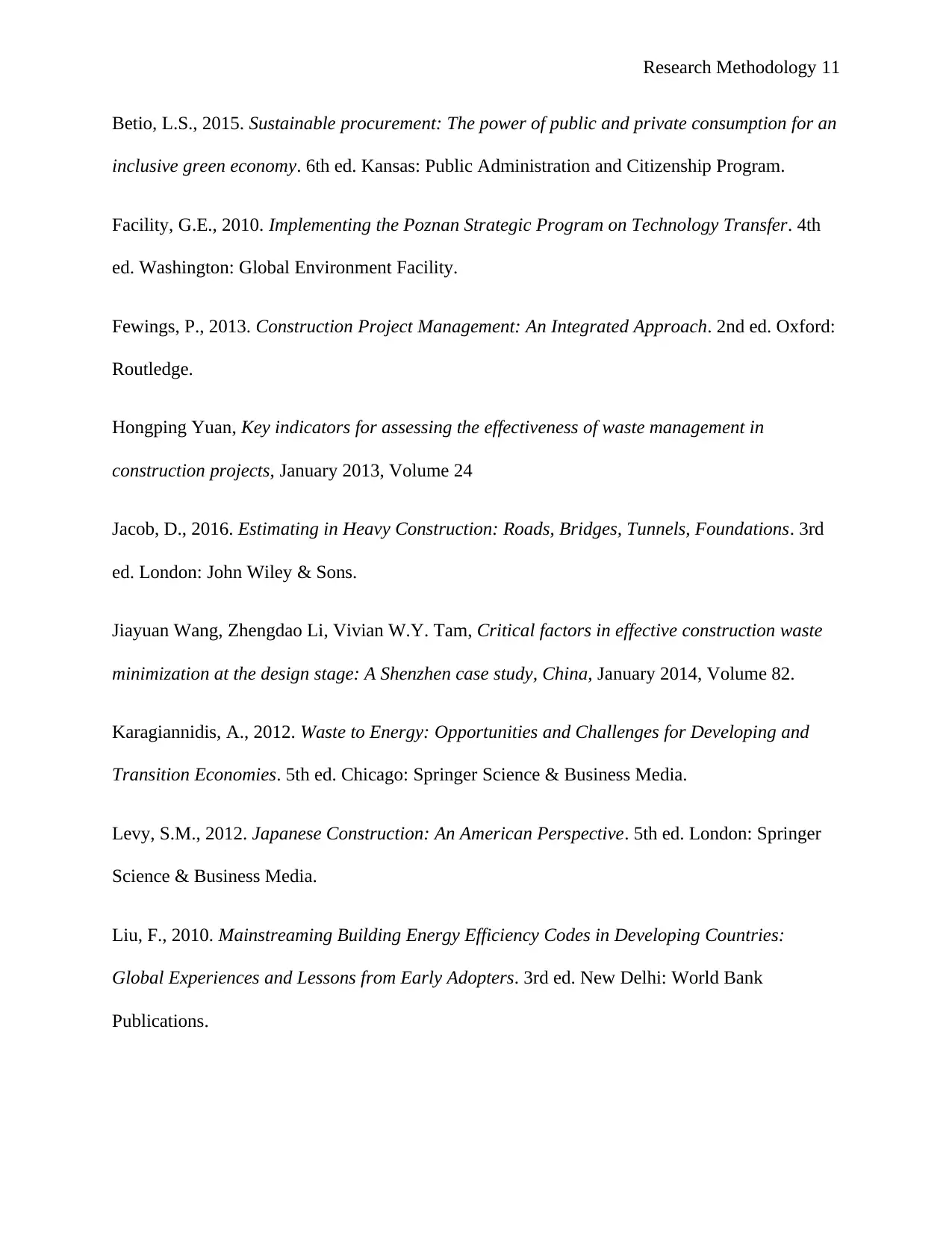
Research Methodology 11
Betio, L.S., 2015. Sustainable procurement: The power of public and private consumption for an
inclusive green economy. 6th ed. Kansas: Public Administration and Citizenship Program.
Facility, G.E., 2010. Implementing the Poznan Strategic Program on Technology Transfer. 4th
ed. Washington: Global Environment Facility.
Fewings, P., 2013. Construction Project Management: An Integrated Approach. 2nd ed. Oxford:
Routledge.
Hongping Yuan, Key indicators for assessing the effectiveness of waste management in
construction projects, January 2013, Volume 24
Jacob, D., 2016. Estimating in Heavy Construction: Roads, Bridges, Tunnels, Foundations. 3rd
ed. London: John Wiley & Sons.
Jiayuan Wang, Zhengdao Li, Vivian W.Y. Tam, Critical factors in effective construction waste
minimization at the design stage: A Shenzhen case study, China, January 2014, Volume 82.
Karagiannidis, A., 2012. Waste to Energy: Opportunities and Challenges for Developing and
Transition Economies. 5th ed. Chicago: Springer Science & Business Media.
Levy, S.M., 2012. Japanese Construction: An American Perspective. 5th ed. London: Springer
Science & Business Media.
Liu, F., 2010. Mainstreaming Building Energy Efficiency Codes in Developing Countries:
Global Experiences and Lessons from Early Adopters. 3rd ed. New Delhi: World Bank
Publications.
Betio, L.S., 2015. Sustainable procurement: The power of public and private consumption for an
inclusive green economy. 6th ed. Kansas: Public Administration and Citizenship Program.
Facility, G.E., 2010. Implementing the Poznan Strategic Program on Technology Transfer. 4th
ed. Washington: Global Environment Facility.
Fewings, P., 2013. Construction Project Management: An Integrated Approach. 2nd ed. Oxford:
Routledge.
Hongping Yuan, Key indicators for assessing the effectiveness of waste management in
construction projects, January 2013, Volume 24
Jacob, D., 2016. Estimating in Heavy Construction: Roads, Bridges, Tunnels, Foundations. 3rd
ed. London: John Wiley & Sons.
Jiayuan Wang, Zhengdao Li, Vivian W.Y. Tam, Critical factors in effective construction waste
minimization at the design stage: A Shenzhen case study, China, January 2014, Volume 82.
Karagiannidis, A., 2012. Waste to Energy: Opportunities and Challenges for Developing and
Transition Economies. 5th ed. Chicago: Springer Science & Business Media.
Levy, S.M., 2012. Japanese Construction: An American Perspective. 5th ed. London: Springer
Science & Business Media.
Liu, F., 2010. Mainstreaming Building Energy Efficiency Codes in Developing Countries:
Global Experiences and Lessons from Early Adopters. 3rd ed. New Delhi: World Bank
Publications.
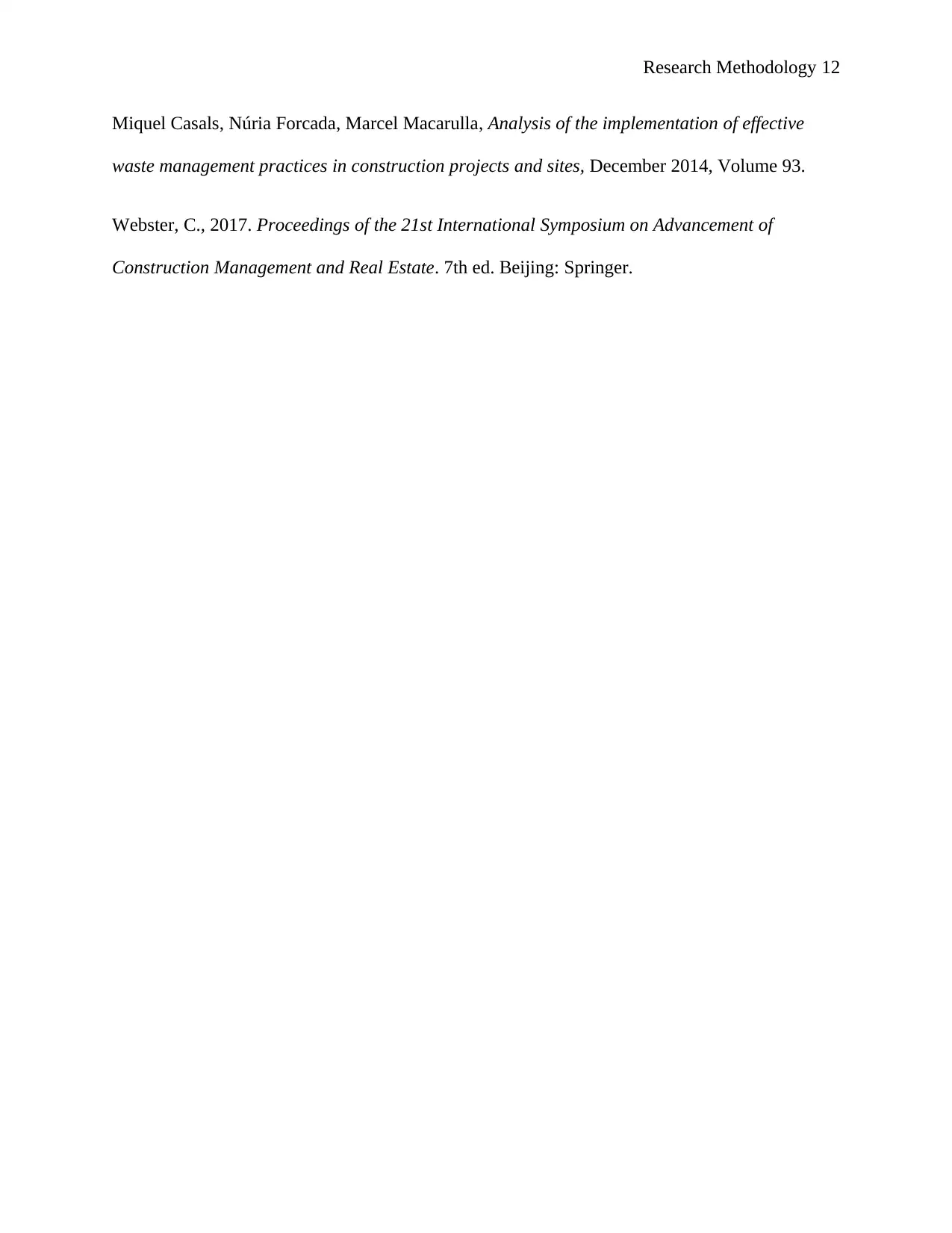
Research Methodology 12
Miquel Casals, Núria Forcada, Marcel Macarulla, Analysis of the implementation of effective
waste management practices in construction projects and sites, December 2014, Volume 93.
Webster, C., 2017. Proceedings of the 21st International Symposium on Advancement of
Construction Management and Real Estate. 7th ed. Beijing: Springer.
Miquel Casals, Núria Forcada, Marcel Macarulla, Analysis of the implementation of effective
waste management practices in construction projects and sites, December 2014, Volume 93.
Webster, C., 2017. Proceedings of the 21st International Symposium on Advancement of
Construction Management and Real Estate. 7th ed. Beijing: Springer.
⊘ This is a preview!⊘
Do you want full access?
Subscribe today to unlock all pages.

Trusted by 1+ million students worldwide
1 out of 12
Related Documents
Your All-in-One AI-Powered Toolkit for Academic Success.
+13062052269
info@desklib.com
Available 24*7 on WhatsApp / Email
![[object Object]](/_next/static/media/star-bottom.7253800d.svg)
Unlock your academic potential
Copyright © 2020–2025 A2Z Services. All Rights Reserved. Developed and managed by ZUCOL.





